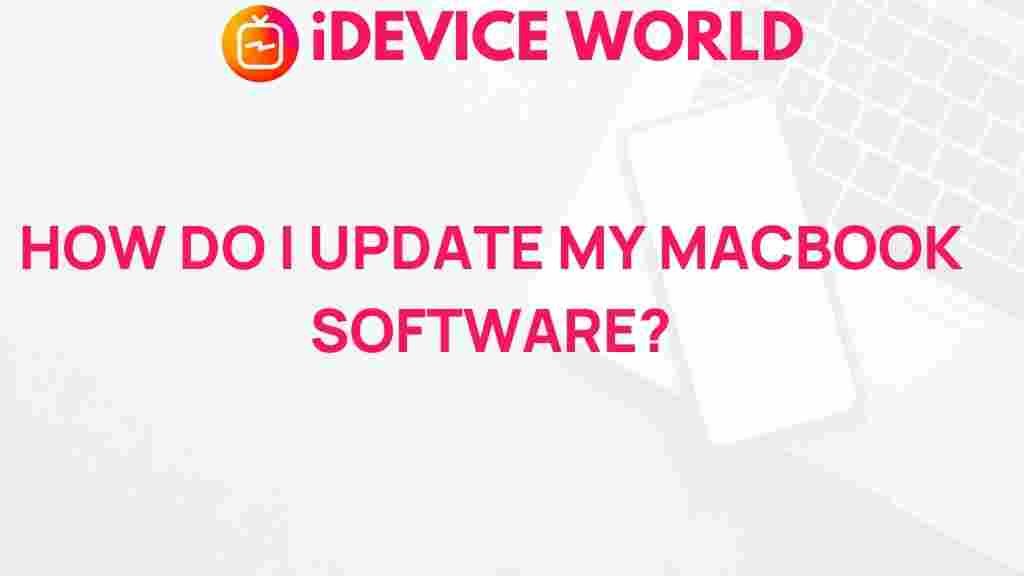Unleash the Power of Your MacBook: A Guide to Updating Software
Your MacBook is more than just a computer; it’s a powerful tool that can enhance your productivity, creativity, and entertainment. However, to unlock its full potential, it’s essential to keep its software up to date. In this comprehensive guide, we’ll walk you through the process of updating your MacBook’s software, troubleshoot common issues, and ensure that you’re making the most out of your device.
Why Update Your MacBook?
Updating your MacBook offers numerous benefits, including:
- Enhanced Security: Updates often include security patches that protect your device from vulnerabilities.
- Improved Performance: Software updates can enhance the speed and efficiency of your MacBook.
- New Features: Each update may introduce new features that enhance usability and productivity.
- Compatibility: Keeping your software updated ensures compatibility with the latest applications and services.
How to Check for Updates on Your MacBook
Before diving into the updating process, it’s crucial to know how to check for updates. Here’s a step-by-step guide:
- Open System Preferences: Click on the Apple logo in the top left corner of your screen and select System Preferences.
- Go to Software Update: In the System Preferences window, find and click on Software Update.
- Check for Updates: Your MacBook will automatically check for available updates. If updates are available, you will see a notification.
Step-by-Step Process to Update Your MacBook
Updating your MacBook’s software is a straightforward process. Follow these steps:
- Back Up Your Data: Before performing any updates, it’s wise to back up your data using Time Machine or another backup solution.
- Connect to Wi-Fi: Ensure your MacBook is connected to a reliable Wi-Fi network to avoid interruptions during the download process.
- Select Update: In the Software Update window, you will see options for available updates. Click on the Update Now button to begin the process.
- Follow Prompts: Follow the on-screen prompts to complete the installation. You may need to enter your administrator password.
- Restart Your MacBook: After the installation is complete, you may need to restart your device for changes to take effect.
Updating macOS Versions
If you’re considering upgrading to a new macOS version, the process is similar but requires a bit more attention:
- Check Compatibility: Ensure your MacBook is compatible with the new macOS version by visiting Apple’s official website.
- Download the Installer: Once you confirm compatibility, download the macOS installer from the App Store or the Software Update section.
- Install the Upgrade: Open the downloaded installer and follow the prompts to install the new version. This may take some time, so ensure your device is plugged in.
- Set Up Your MacBook: After the installation, follow the setup assistant to configure your settings.
Troubleshooting Common Update Issues
Sometimes, updating your MacBook might not go as planned. Here are some common issues and how to troubleshoot them:
- Slow Download Speeds: If your update is downloading slowly, try switching to a wired connection or restarting your router.
- Update Fails: If the update fails, restart your MacBook and try checking for updates again. You can also reset the NVRAM or PRAM.
- Insufficient Storage: If you receive a message about insufficient storage, consider deleting unnecessary files or moving them to an external drive.
- Stuck on the Update Screen: If your MacBook gets stuck during an update, force restart your device by holding down the power button until it shuts down.
Maintaining Your MacBook After Updates
Once you’ve updated your MacBook, here are some tips for maintaining its performance:
- Regular Backups: Continue backing up your data regularly to prevent data loss.
- Monitor Storage: Keep an eye on your storage space and clean up unnecessary files.
- Update Apps: Regularly check for app updates to ensure they’re compatible with the latest macOS version.
- Stay Informed: Follow Apple’s news for any upcoming updates or security notices.
Conclusion
Updating your MacBook is an essential task that can significantly enhance its performance and security. By following the steps outlined in this guide, you can ensure that your device remains up to date and continues to meet your needs effectively. Remember to perform regular backups and stay informed about the latest updates. By doing so, you will unleash the full power of your MacBook, maximizing its capabilities for work and play.
For further information, check out the official Apple support page on software updates.
This article is in the category Guides & Tutorials and created by iDeciveWorld Team
